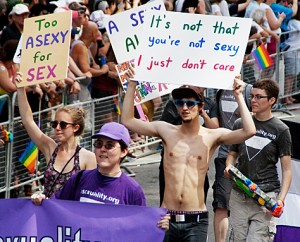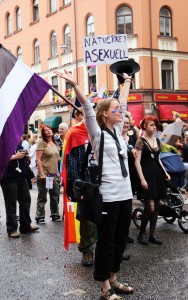Being an asexual in a sex-saturated culture is to fight the accusations of being abnormal or medically sick. Making asexuality visible is the challenge that online communities like AVEN have risen to
By Kristina Gupta
In many contemporary societies, there is a great deal of pressure on people to be sexual and to engage in sexual activity. Unfortunately, asexuality is often considered as a state of denial even within the progressive circles.
In response, in the past decade, online communities of people who identify as asexuals have been formed – the largest of which is the Asexuality Visibility and Education Network (AVEN) founded in 2001. AVEN defines asexuality as follows: “an asexual person is someone who does not experience sexual attraction.” AVEN has two stated goals: to educate about asexuality and to create a community for asexual people.
As of March 2012, over 34,000 people were registered members of AVEN. According to a recent survey, the majority of AVEN members are under the age of 25. Around 65% of the community identifies as female and around 14% identifies as male. AVEN was started in the United States, and the majority of members are from the U.S., Canada, and Europe. AVEN also has members from all over the world.
There are also a number of affiliated sites in different languages, – there are several Spanish-language sites that connect asexual Spanish speakers and their allies all over the world. Besides these, there are a number of other websites focused on asexuality, including blogs, dating sites, and other community forums.
There is a great deal of diversity within the asexual community, even in terms of sexuality. Asexual individuals also vary in the types of intimate relationships they desire; some may identify as “romantic asexual” if they want romantic relationships that don’t involve sexual activity, while others may identify as “aromantic asexual.” Some romantic asexuals may also adopt an identity label based on the gender of their preferred romantic partner (e.g. some romantic asexuals will identify as hetero-romantic or homo-romantic).
While many asexual individuals feel that they have been asexual their entire lives, there may be some people who move in and out of the category. In this sense, asexuality is not very different from other sexual identity categories, as some individuals may maintain a stable sexual identity throughout their lives, while others may have more fluid sexual identities.
Asexual individuals who live in a sex-saturated culture may feel stigmatized or marginalized. In the U.S., for example, asexual adults may be perceived as strange or even sick. The handbook of mental disorders used in the United States (the American Psychiatric Association’s (APA) Diagnostic and Statistical Manual or DSM) includes a mental disorder called “hypoactive sexual desire disorder,” which is defined as a persistent lack of interest in sex.
For the asexual community, a lack of interest in sex is not always a medical condition; in some cases, it can be a fulfilling way of being in the world. Some members of AVEN want the APA to revise the definition of hypoactive sexual desire disorder to exclude people who identify as asexual.
In cultures where marriage and children are what is expected (which is still the case, to a certain extent, even in the U.S), some asexual individuals may feel coerced by society to accept the ‘norm’. It could be that some asexual individuals seek refuge in religious institutions where celibacy is accepted or mandated, but there isn’t enough research to support the case.
In some ways, asexuality fits comfortably within the GLBTQ community, as asexuality is another “non-normative” sexuality. However, much of the GLBTQ community (in the U.S. at least) is very sex-focused, so some asexual individuals might not feel comfortable. In recent years, there has been some collaboration between AVEN and different GLBTQ groups; for example, for the last few years, a group of AVEN members has marched in the San Francisco Pride Parade.
As asexuality is a relatively new sexual identity category, there has been little feminist research on it to date. Since the early 1990s, much of western feminism has been very “pro-sex,” which might have prevented early recognition and acceptance of asexuality.
However, currently there are a number of feminist scholars considering the implications of asexuality for feminist theory and practice which include Kristin Scherrer, Karli June Cerankowski and Megan Milks, Ela Przybylo, and Eunjung Kim.
Integrating considerations of asexuality into feminist theory and practice will be very productive. Considerations of asexuality can lead us to question our “pro-sex biases”; encourage us to question the boundaries between the sexual and the nonsexual and between romance and friendship. It could also lead to us to think about new types of relationships and affinities, and encourage us to think more deeply about the prevalence and meaning of “unwanted sexuality.”
Kristina Gupta is a Ph.D. candidate in the Department of Women, Gender, and Sexuality Studies at Emory University. For her dissertation, she is researching the intersections of feminist theory, asexuality, and scientific and medical research on sexual desire
Related reading: ‘We’re married, we just don’t have sex’


Interesting read indeed! It is true that there are many who consider themselves Asxual. I hope someday we will acknowledge them too.
It would be a good idea to build a community of asexual people in India, which I feel we don’t have yet. Media coverage of the topic is only a baby step towards talking about asexuality in India. A forum and a community, i.e., concerted efforts have to bring in asexuality as an acknowledged and celebrated part of the wide spectrum of sexuality.